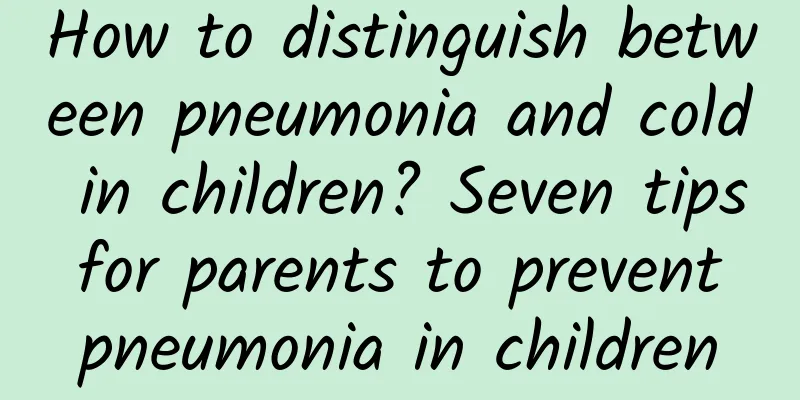How to treat physiological jaundice in infants? Master the three treatments for physiological jaundice in infants

|
When newborns develop jaundice, many parents will be very nervous at first. But in fact, newborn jaundice includes physiological jaundice, breast milk jaundice and pathological jaundice. Physiological jaundice is a normal physiological phenomenon, which generally does not have adverse effects on children and can disappear on its own. What you need to do is to breastfeed normally, increase the number of feedings appropriately, promote defecation, and get some sun exposure appropriately. Neonatal jaundice is caused by excessive bilirubin concentration in the body, which causes the baby's skin and mucous membranes to turn yellow visibly. Clinically, neonatal jaundice is divided into three types: physiological jaundice, breast milk jaundice, and pathological jaundice. Among them, physiological jaundice in infants is a normal physiological phenomenon, which mostly occurs within 2-5 days after the birth of the newborn, and the jaundice index is not higher than 15mg/dl. So, what should we do when a baby has physiological jaundice? 1. When a baby develops physiological jaundice, apart from the skin and mucous membranes turning yellow, there will be no other adverse symptoms. The baby can eat and sleep, and has normal bowel movements. At this time, normal breastfeeding is all that is needed, and there is no need for excessive intervention treatment. 2. For full-term infants, physiological jaundice will subside within 10-14 days after birth; for about 80% of premature infants, physiological jaundice will subside within 3-4 weeks after onset. During this period, except for a few who may eat poorly, the child will not have symptoms such as poor spirits, poor appetite, diarrhea, fever, abnormal crying, etc. If it does not subside after a few days, you can check the jaundice index. As long as the index does not exceed 15mg/dl, increase the number of feedings appropriately to promote the baby's bowel movements, which can accelerate the excretion of bilirubin. 3. During the period of physiological jaundice, you can take your child to bask in the sun appropriately, because the ultraviolet rays in the sun can help the jaundice subside, but you must pay attention to protecting the baby's eyes during the sunbathing process and avoid direct sunlight on the baby's eyes. The time can be arranged between 7-8 am and 4-6 pm, when the sunlight is relatively soft, and the baby should be avoided from being exposed to the sun. Because physiological jaundice is a normal physiological phenomenon of newborns, it will not have adverse consequences on their bodies and can disappear on its own, so basically no additional intervention treatment is required. However, it is necessary to prevent the occurrence of breast milk jaundice or pathological jaundice in newborns. Once the jaundice index of the newborn is too high, the jaundice has not subsided, and it is accompanied by other abnormal conditions such as abnormal crying and fever, it is recommended to seek medical attention directly and take active treatment measures. |
<<: What are the causes of neonatal fever? To prevent neonatal jaundice, you need to do these
Recommend
What should I do if my baby has a cough, runny nose, or diarrhea? How should I use medicine if my baby has a cough, runny nose, or diarrhea?
Babies have very low resistance, so coughing, run...
Symptoms of hand, foot and mouth disease in the first three days
Hand, foot and mouth disease is not unfamiliar in...
How is the 999 cold granules for children? There are three taboos to be aware of when using 999 cold granules
The effect of 999 cold granules for children is v...
What to do if your three-month-old baby has a dry cough
If a three-month-old baby has a dry cough, you ca...
Causes of mumps in children
The main causes of mumps in children include vira...
What are the dangers of childhood pneumonia to children?
Neonatal pneumonia is a common disease and it occ...
How many eggs a day is the most nutritious? What are the benefits of eating more eggs?
Eggs are one of the recognized nutritious foods i...
Where to treat acute laryngitis in children
Once a disease like acute laryngitis in children ...
Symptoms of jaundice in children
As we all know, many newborns will have jaundice ...
Prevention of pneumonia in children starts from five aspects Daily dietary taboos for pneumonia in children
Pediatric pneumonia is a relatively common respir...
What are the dangers of ADHD in children?
ADHD is a common childhood disease in clinical pr...
How to identify pneumonia in children? Five key points to prevent pneumonia in children
Pneumonia refers to inflammation of the lung pare...
Can children with pneumonia develop leukemia?
Can children with pneumonia develop leukemia? Chi...
Is jaundice 13 high at 7 days old?
7 days after birth, jaundice is 13mg/dl. Whether ...
What kind of milk powder is better for babies with eczema? What is the reason for babies to be allergic to milk powder?
Pediatric eczema is a common disease, and many ba...









